Imagination Announces A-Series GPU Architecture: "Most Important Launch in 15 Years"
by Andrei Frumusanu on December 2, 2019 8:00 PM ESTHyperLane Technology
Another new addition to the A-Series GPU is Imagination's “HyperLane” technology, which promises to vastly expand the flexibility of the architecture in terms of multi-tasking as well as security. Imagination GPUs have had virtualization abilities for some time now, and this had given them an advantage in focus areas such as automotive designs.
The new HyperLane technology is said to be an extension to virtualization, going beyond it in terms of separation of tasks executed by a single GPU.
In your usual rendering flows, there are different kinds of “master” controllers each handling the dispatching of workloads to the GPU; geometry is handled by the geometry data master, pixel processing and shading by the 3D data master, 2D operations are handled by the 2D data, master, and compute workloads are processed by the, you guessed it, the compute data master.
In each of these processing flows various blocks of the GPU are active for a given task, while other blocks remain idle.
HyperLane technology is said to be able to enable full task concurrency of the GPU hardware, with multiple data masters being able to be active simultaneously, executing work dynamically across the GPU’s hardware resources. In essence, the whole GPU becomes multi-tasking capable, receiving different task submissions from up to 8 sources (hence 8 HyperLanes).
The new feature sounded to me like a hardware based scheduler for task submissions, although when I brought up this description the Imagination spokespeople were rather dismissive of the simplification, saying that HyperLanes go far deeper into the hardware architecture, with for example each HyperLane having being able to be configured with its own virtual memory space (or also sharing arbitrary memory spaces across hyperlanes).
Splitting GPU resources can happens on a block-level concurrently with other tasks, or also be shared in the time-domain with time-slices between HyperLanes. Priority can be given to HyperLanes, such as prioritizing graphics over a possible background AI task using the remaining free resources.
The security advantages of such a technology also seem advanced, with the company use-cases such as isolation for protected content and rights management.
An interesting application of the technology is the synergy it allows between an A-Series GPU and the company’s in-house neural network accelerator IP. It would be able to share AI workloads between the two IP blocks, with the GPU for example handling the more programmable layers of a model while still taking advantage of the NNA’s efficiency for the fixed function fully connected layer processing.
Three Dozen Other Microarchitectural Improvements
The A-Series comes with other numerous microarchitectural advancements that are said to be advantageous to the GPU IP.
One such existing feature is the integration of a small dedicated CPU (which we understand to be RISC-V based) acting as a firmware processor, handling GPU management tasks that in other architectures might be still be handled by drivers on the host system CPU. The firmware processor approach is said to achieve more performant and efficient handling of various housekeeping tasks such as debugging, data logging, GPIO handling and even DVFS algorithms. In contrast as an example, DVFS for Arm Mali GPUs for example is still handled by the kernel GPU driver on the host CPUs.
An interesting new development feature that is enabled by profiling the GPU’s hardware counters through the firmware processor is creating tile heatmaps of execution resources used. This seems relatively banal, but isn’t something that’s readily available for software developers and could be extremely useful in terms of quick debugging and optimizations of 3D workloads thanks to a more visual approach.


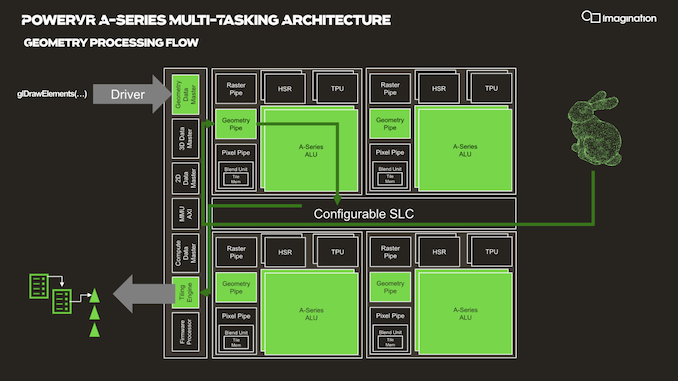
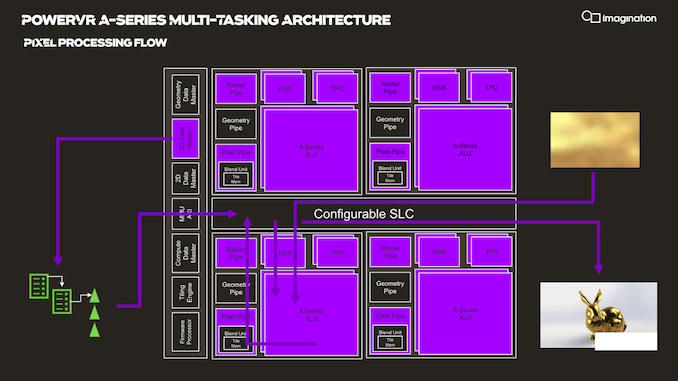
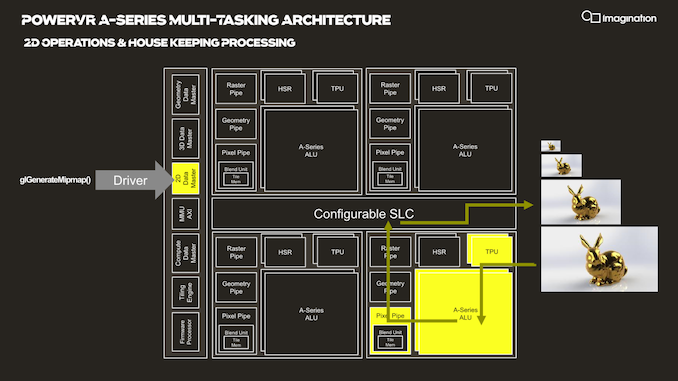
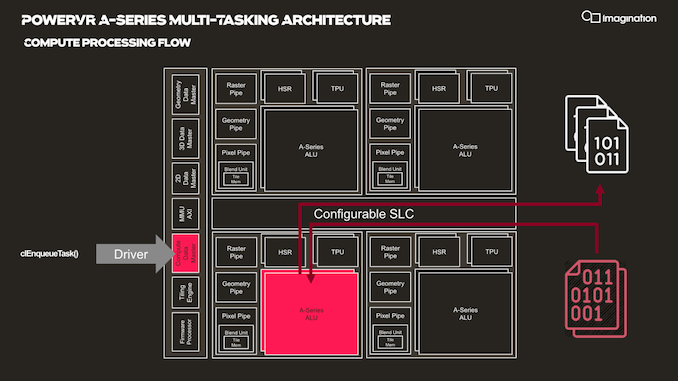
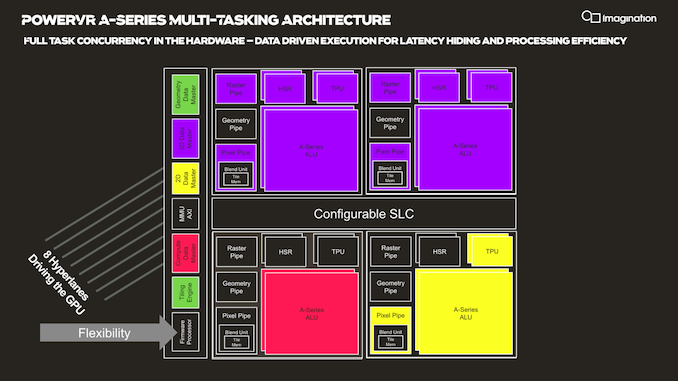
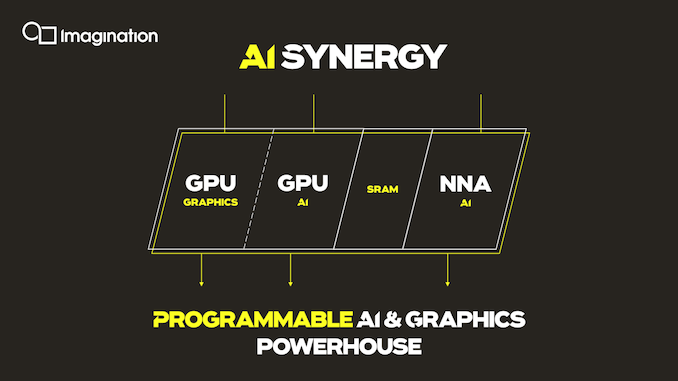
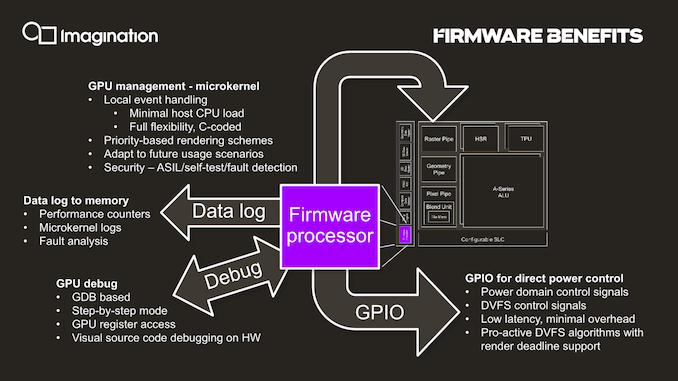
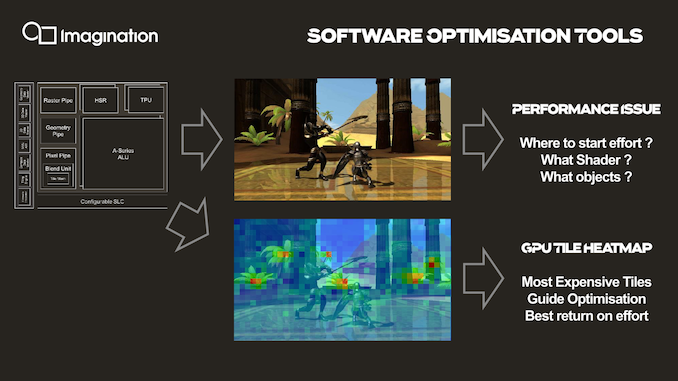








143 Comments
View All Comments
Etain05 - Tuesday, December 3, 2019 - link
I think that’s for tablets, and the AXT-64-2048 is just a possible option. If you want to consider the AXT-48-1536, you’d have to compare it to the A12X and whatever comes next.vladx - Wednesday, December 4, 2019 - link
Well B series should be available to customers in 2020 so a BXT-32-1024 should crush the A14 assuming the 30% improvements will be accomplished.Etain05 - Wednesday, December 4, 2019 - link
The A series will be in devices in the second half of 2020, there’s absolutely no way that the B series will be available to customers in 2020. The B series will be available in 2021, when it will compete with the A15.vladx - Wednesday, December 4, 2019 - link
By customers I meant SoC manufacturers, like MediaTek and phones using B-series SocS could be made available before A15 since Apple releases new phones in Q4 usually.Etain05 - Wednesday, December 4, 2019 - link
Even if we were to be generous in our assumptions, the soonest we’ll see any device with a B-series would be Q3 2021, so at most a few months before the A15. The competition would still be the A15, not the A14. Even more importantly, there’s almost no smartphone that comes out in Q3, apart from some in August and September, which is exactly the time when the A15 will be out too.rbanffy - Tuesday, December 3, 2019 - link
It's still a numeric naming scheme. 0xA comes after 0x9, after all.mode_13h - Wednesday, December 4, 2019 - link
Yeah, but he asked and they denied it. They should've been like "hey... yeah! yeah, that's exactly right!", except the question was probably fielded by an ignorant marketing drone who doesn't know about hexadecimal.In fact, maybe whoever actually thought of the naming scheme planned it exactly like that, but that reasoning somehow failed to get communicated.
domboy - Tuesday, December 3, 2019 - link
Oh... so they aren't announcing a new Kyro video card... oh well... :/mode_13h - Wednesday, December 4, 2019 - link
Nice one. At first, I thought you confused it with Qualcomm's "Kryo" cores, but misspelled it.https://en.wikipedia.org/wiki/PowerVR#Series3_(STM...
https://en.wikipedia.org/wiki/Kryo
wrkingclass_hero - Tuesday, December 3, 2019 - link
I wish them success and hope to see them get plenty of design wins. I have never actually owned a PowerVR product, but I've been sort of a distant fan (over here in Android land) and look forward to seeing how they perform. If they do well, who knows, they may even reenter the console market with the next-gen portables.